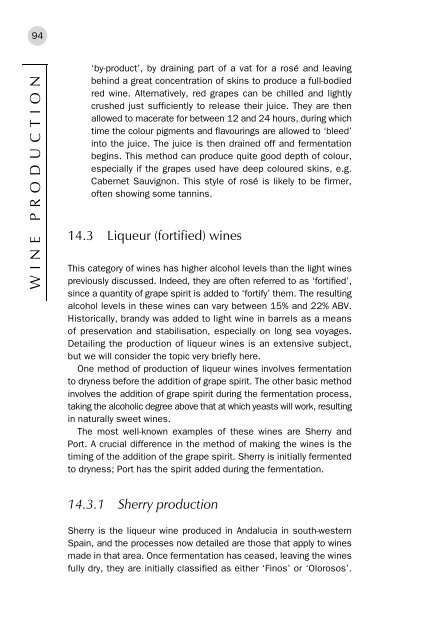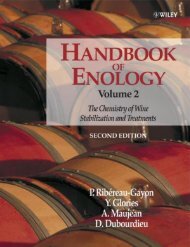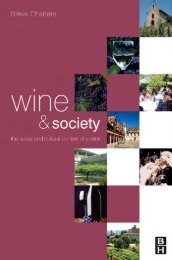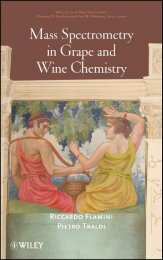Wine Production : Vine to Bottle - Vinum Vine
Wine Production : Vine to Bottle - Vinum Vine
Wine Production : Vine to Bottle - Vinum Vine
Create successful ePaper yourself
Turn your PDF publications into a flip-book with our unique Google optimized e-Paper software.
94<br />
WINE PRODUCTION<br />
‘by-product’, by draining part of a vat for a rosé and leaving<br />
behind a great concentration of skins <strong>to</strong> produce a full-bodied<br />
red wine. Alternatively, red grapes can be chilled and lightly<br />
crushed just sufficiently <strong>to</strong> release their juice. They are then<br />
allowed <strong>to</strong> macerate for between 12 and 24 hours, during which<br />
time the colour pigments and flavourings are allowed <strong>to</strong> ‘bleed’<br />
in<strong>to</strong> the juice. The juice is then drained off and fermentation<br />
begins. This method can produce quite good depth of colour,<br />
especially if the grapes used have deep coloured skins, e.g.<br />
Cabernet Sauvignon. This style of rosé is likely <strong>to</strong> be firmer,<br />
often showing some tannins.<br />
14.3 Liqueur (fortified) wines<br />
This category of wines has higher alcohol levels than the light wines<br />
previously discussed. Indeed, they are often referred <strong>to</strong> as ‘fortified’,<br />
since a quantity of grape spirit is added <strong>to</strong> ‘fortify’ them. The resulting<br />
alcohol levels in these wines can vary between 15% and 22% ABV.<br />
His<strong>to</strong>rically, brandy was added <strong>to</strong> light wine in barrels as a means<br />
of preservation and stabilisation, especially on long sea voyages.<br />
Detailing the production of liqueur wines is an extensive subject,<br />
but we will consider the <strong>to</strong>pic very briefly here.<br />
One method of production of liqueur wines involves fermentation<br />
<strong>to</strong> dryness before the addition of grape spirit. The other basic method<br />
involves the addition of grape spirit during the fermentation process,<br />
taking the alcoholic degree above that at which yeasts will work, resulting<br />
in naturally sweet wines.<br />
The most well-known examples of these wines are Sherry and<br />
Port. A crucial difference in the method of making the wines is the<br />
timing of the addition of the grape spirit. Sherry is initially fermented<br />
<strong>to</strong> dryness; Port has the spirit added during the fermentation.<br />
14.3.1 Sherry production<br />
Sherry is the liqueur wine produced in Andalucia in south-western<br />
Spain, and the processes now detailed are those that apply <strong>to</strong> wines<br />
made in that area. Once fermentation has ceased, leaving the wines<br />
fully dry, they are initially classified as either ‘Finos’ or ‘Olorosos’.
















